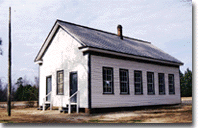39a. Education

Demands for better public education were many. Employers wanted a better educated workforce, at least for the technical jobs. Classical liberals believed that public education was the cornerstone of any democracy. Our system of government could be imperiled if large numbers of uneducated masses voted unwisely.
Teaching America's Youth
Church leaders and modern liberals were concerned for the welfare of children. They believed that a strong education was not only appropriate, but an inalienable right owed to all. Furthermore, critics of child labor practices wanted longer mandatory school years. After all, if a child was in school, he or she would not be in the factory.
In 1870, about half of the nation's children received no formal education whatsoever. Although many states provided for a free public education for children between the ages of 5 and 21, economic realities kept many children working in mines, factories, or on the farm. Only six states had compulsory education laws at this point, and most were for only several weeks per year.
Massachusetts was the leader in tightening laws. By 1890, all children in Massachusetts between the ages of 6 and 10 were required to attend school at least twenty weeks per year. These laws were much simpler to enact than to enforce. Truant officers would be necessary to chase down offenders. Private and religious schools would have to be monitored to ensure quality standards similar to public schools. Despite resistance, acceptance of mandatory elementary education began to spread. By the turn of the century such laws were universal throughout the North and West, with the South lagging behind.
Under the laws of Jim Crow, the public schools in operation in the South were entirely segregated by race in 1900. Mississippi became the last state to require elementary education in 1918.
Other reforms began to sweep the nation. Influenced by German immigrants, kindergartens sprouted in urban areas, beginning with St. Louis in 1873. Demands for better trained teachers led to an increase in "normal" schools, colleges that specialized in preparation to teach. By 1900, one in five public school teachers had a degree.
More and more high schools were built in the last three decades of the 19th century. During that period the number of public high schools increased from 160 to 6,000, and the nation's illiteracy rate was cut nearly in half. However, only 4% of American children between the ages of 14 and 17 were actually enrolled.
Higher Education for All
Higher education was changing as well. In general, the number of colleges increased owing to the creation of public land-grant colleges by the states and private universities sponsored by philanthropists, such as Stanford and Vanderbilt.
Opportunities for women to attend college were also on the rise. Mt. Holyoke, Smith, Vassar, Wellesley, and Bryn Mawr Colleges provided a liberal arts education equivalent to their males-only counterparts. By 1910, 40% of the nation's college students were female, despite the fact that many professions were still closed to women.
Although nearly 47% of the nation's colleges accepted women, African American attendance at white schools was virtually nonexistent. Black colleges such as Howard, Fisk, and Atlanta University rose to meet this need.






